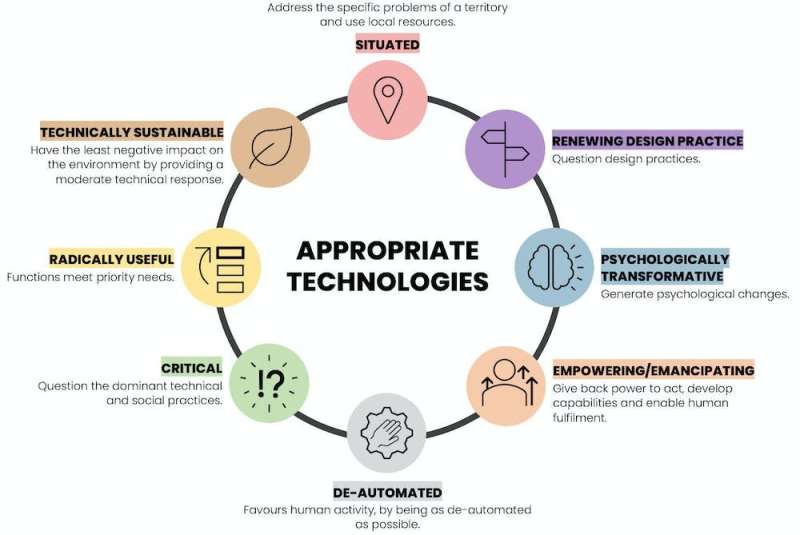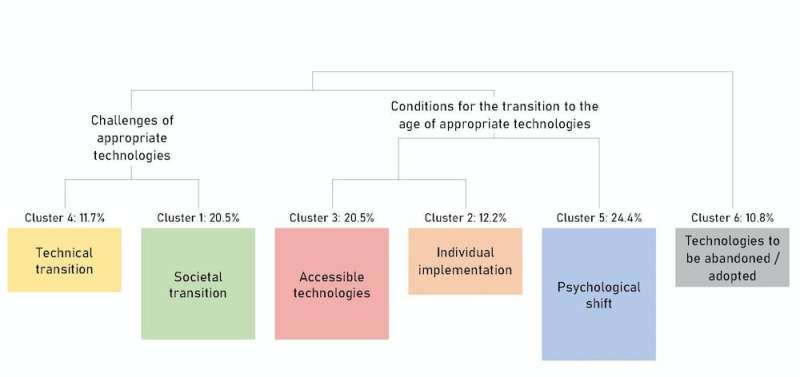This article has been reviewed according to Science X's editorial process and policies. Editors have highlighted the following attributes while ensuring the content's credibility:
fact-checked
trusted source
written by researcher(s)
proofread
In a world of limited resources, the future is low-tech—providing we make products more user-friendly

Semiconductors for electric vehicles have been in short supply since 2020. The causes are multiple, including water shortages in producing countries and increasingly high-tech models in Europe.
Could this be the opportunity to rethink our reliance on these technologies? Indeed, we are facing a paradox. In response to the ecological crisis, we tend to favor high-tech solutions, even though they increase the pressure on living environments, take a long time to implement, and are often produced in poor working conditions. In a world of limited resources, it is therefore appropriate to question our view of technology as the go-to-solution to environmental challenges.
So-called appropriate technologies are those that are less complex, consume fewer resources, and have the least possible negative impact at a human and environmental level. They are one avenue of technical frugality to explore. This approach is becoming increasingly credible, with the emergence of a structured ecosystem in France and its inclusion in one of the government's plan to reach carbon neutrality by 2050.
A technological change but also a human one
In a study we conducted among experts in France, we propose to define appropriate technologies as:
"A set of objects, services and practices whose design is constrained by the need to care for humans and the environments of production/use of which they are part."

We also sought to identify the characteristics that would help define the appropriate technology approach. These include a renewal of design methods, a psychological transformation, user empowerment, a tendency to favor de-automation, as well as a taste for radical usefulness and technical sustainability.
These characteristics reveal that appropriate technologies are not defined solely by a difference in technical intensity with high-techs, but rather by a global approach that also includes strong human and social dimensions. Since, in France, the appropriate-technology movement was popularized and developed by engineers, human factors are still rarely taken into account or are limited to the question of social acceptability. Their impact on the organization of work, ease of use issues and the way they change the satisfaction of human needs remain to be explored.
Barriers to use
In a recent report, France's ecological transition agency Ademe identifies four barriers to the deployment of appropriate technologies: regulatory, cultural, economic and semantic. What's missing are usability barriers.
Theoretical models of technology acceptance—models that explain the factors that drive technology adoption—emphasize that the quality of interaction between users and artifacts can be a major barrier. Indeed, they identify utility and usability as significant determinants of technology use. In the case of appropriate technologies, they seem all the more important.
To identify these obstacles in more details, we conducted a study on the public's representations. It was done in partnership with the Low-tech Lab, an association that aims to disseminate the appropriate technology approach. (In French, the term "low-techs" is commonly used to refer to "appropriate technologies"; the equivalent of the Low-tech Lab in the US would be the NCAT.) As conditions for the transition to appropriate technologies, those surveyed saw the following factors as being important: their accessibility, the ability to use them autonomously, and the need for a psychological change, which confirms the importance of the obstacles related to use.
To go further, in another study, we categorized the problems faced by users (actual and potential) of appropriate technologies.

Recommendations for appropriate technologies designers
In total, 14 categories of problems appear, such as performance, usefulness, pleasure, production/installation, know-how, safety and legal compliance.
These and others stem from two main factors. First, appropriate technologies require more user involvement than conventional technologies. They're less automated and less digital, as the user takes over much of what is currently handled by automation or standardized industrial processes. These can be compensated for by, for example, making the unusual parts of the device with which the user must interact clearly visible and understandable.
Furthermore, appropriate technologies sometimes have a rudimentary/makeshift aspect. In a perspective of empowerment, but also of environmental sustainability, appropriate technologies are not necessarily manufactured and installed by professionals. This can have consequences on their safe use, the understandability of their functioning, and other aspects.
This is why we have formalized seven design recommendations to allow those making appropriate technologies to become aware of these usability issues and thus avoid them. Our goal was to guide practitioners on the aspects related to the interaction between humans and appropriate technologies, while remaining in line with the appropriate technology "philosophy." If some recommendations tackle the right level of technical intensity to propose, others aim at facilitating their use.
Changing the way we design technologies and interactions
While appropriate technologies appear relevant for addressing the ecological and social transition, the "human" obstacles to their wider adoption are not only caused by "mental representation" issues but also by concrete questions of use (accessibility, usability, etc.) that require us to think about technical sobriety in terms of user experience.
Other obstacles exist as well. For example, designers may not be inclined to design appropriate technologies, because this approach calling for "technological discernment" is not the classic way for them to showcase their skills or those of their companies.
In recent years, many studies have tried to shed light on the appropriate technology approach. Let us however remain modest. It will not be possible, nor desirable, to "solve" all user-experience problems. Indeed, appropriate technologies invite us to accept a measure of "friction," to take time, to question needs and choose priorities. In short, they invite us not to reproduce the design practices that have contributed to the current environmental crisis.
This article is republished from The Conversation under a Creative Commons license. Read the original article.![]()















